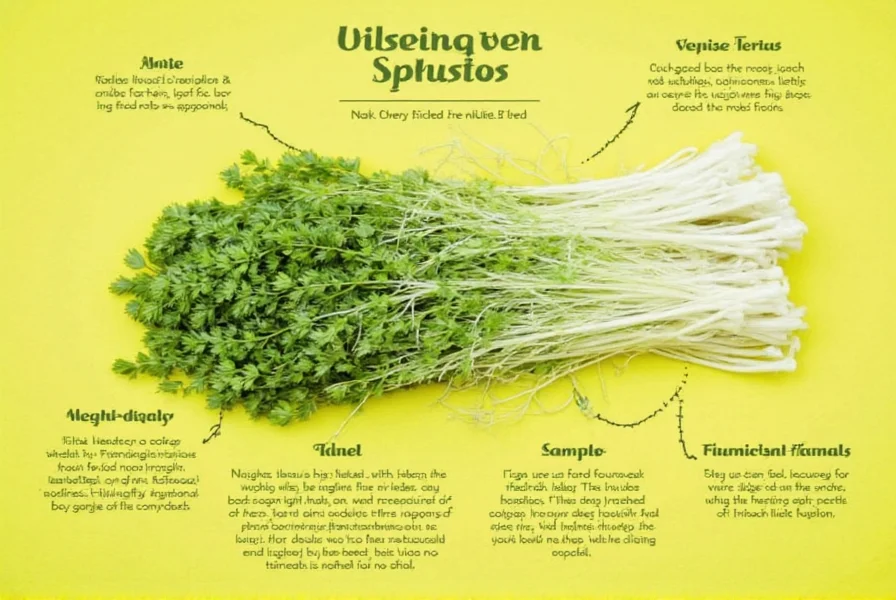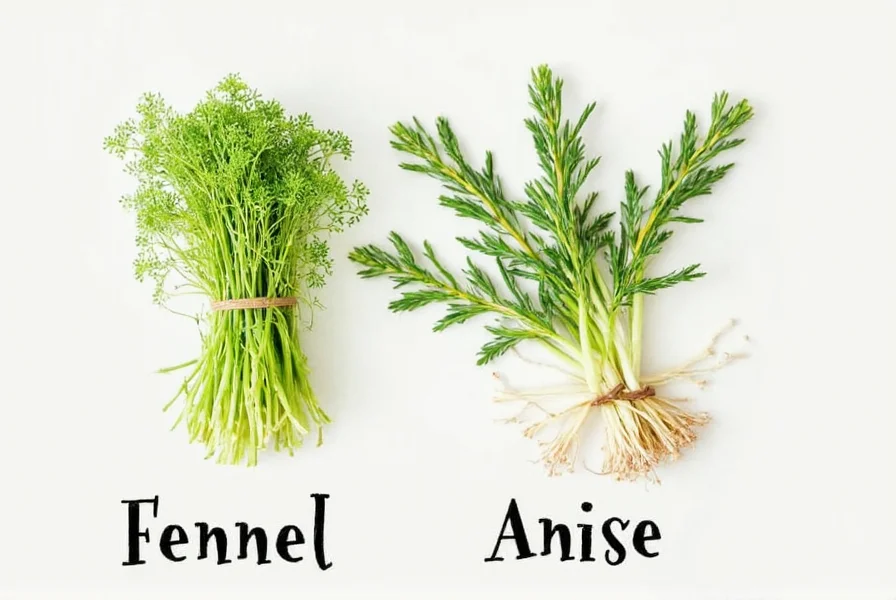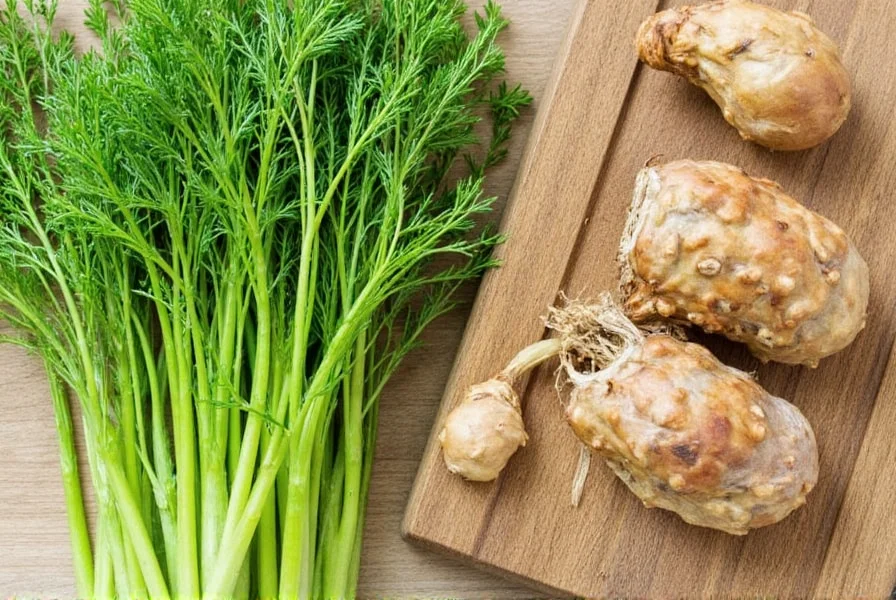Many home cooks and food enthusiasts confuse fennel and anise due to their similar aromatic profiles, but these plants belong to different genera within the Apiaceae family and offer unique culinary properties. This comprehensive guide clarifies the botanical distinctions, flavor characteristics, and practical applications of both herbs to help you use them correctly in your kitchen.
Botanical Classification: Understanding the Family Tree
Though both plants share the distinctive anethole compound responsible for their licorice-like flavor, they're taxonomically distinct. Fennel (Foeniculum vulgare) is a hardy perennial herb that develops a substantial bulb at its base, while anise (Pimpinella anisum) is an annual plant grown exclusively for its seeds. Many people also confuse these with star anise (Illicium verum), which comes from a completely different plant family (Schisandraceae) native to China.
The confusion between fennel vs anise difference stems from their shared flavor compound anethole, which constitutes 80-90% of anise essential oil and 50-60% of fennel essential oil. However, fennel contains additional compounds like estragole and fenchone that create a more complex flavor profile with subtle grassy notes.
| Characteristic | Fennel | Anise |
|---|---|---|
| Botanical Name | Foeniculum vulgare | Pimpinella anisum |
| Plant Type | Perennial herb with bulb | Annual herb (no bulb) |
| Edible Parts | Bulb, stalks, fronds, seeds | Seeds only |
| Flavor Intensity | Milder, sweeter with herbal notes | Stronger, more intense licorice flavor |
| Primary Culinary Use | Versatile: raw, roasted, in stocks | Primarily in baking and liqueurs |
Physical Characteristics: Identifying Each Plant
Fennel presents as a substantial plant reaching 3-5 feet tall with a distinctive swollen bulb at the base, feathery green fronds resembling dill, and yellow flowers that develop into oval seeds. The entire plant is edible - the crisp bulb works well raw in salads or roasted, the stalks function like celery, and the delicate fronds serve as garnish.
Anise grows to about 2 feet tall with fine, feathery leaves but no bulb formation. Its small white flowers produce the characteristic anise seeds - grayish-brown crescent-shaped seeds about 1/8 inch long. Unlike fennel, only the seeds have culinary value, though the plant's appearance during growth might remind you of fennel or dill.

Flavor Profiles and Culinary Applications
When comparing anise seed vs fennel seed, the flavor differences become apparent. Anise seeds deliver a powerful, pure licorice punch that dominates baked goods and liqueurs like ouzo and anisette. Fennel seeds offer a more nuanced flavor - still licorice-like but with subtle earthy, sweet notes that work well in Italian sausage, Indian spice blends, and Mediterranean vegetable dishes.
The fresh bulb of Florence fennel provides a completely different culinary experience - crisp and mildly sweet with a subtle anise note that mellows beautifully when cooked. Chefs often roast or braise fennel bulbs to enhance their natural sweetness, while anise seeds typically enter dishes during the early cooking stages to infuse flavor throughout.
Understanding whether to use fennel or anise depends on your recipe's requirements. For dishes where texture matters (like salads or roasted vegetable medleys), fresh fennel is irreplaceable. When you need intense licorice flavor in baked goods or spirits, anise seeds deliver more potency. Many Mediterranean and Indian recipes specifically call for one or the other because they create distinctly different flavor profiles.
Substitution Guidance: When Can You Swap Them?
Many home cooks wonder can I substitute fennel for anise in recipes. The answer depends on which part you're substituting and the specific dish:
- Fennel seeds for anise seeds: Use 1.5 times the amount of fennel seeds when replacing anise, as fennel's flavor is milder. Works acceptably in most savory applications but may disappoint in traditional anise-forward baked goods.
- Anise seeds for fennel seeds: Use half the amount of anise seeds when replacing fennel, as anise is significantly stronger. Best for robust dishes where intense licorice flavor is welcome.
- Fresh fennel bulb: No suitable anise substitute exists for the bulb's texture and mild flavor. Celery with a drop of anise extract provides the closest approximation.
Professional chefs note that while these herbs share flavor compounds, their unique chemical profiles mean they're not perfectly interchangeable. Dishes developed specifically for one herb often lose authenticity when substituting the other.
Health Considerations and Traditional Uses
Both plants have documented traditional medicinal uses, though scientific research varies in its support. Fennel has been studied more extensively for digestive benefits, with research suggesting fennel tea may help reduce infant colic and menstrual discomfort. Anise has a long history of use as an expectorant and digestive aid, though high-quality clinical evidence remains limited.
Important safety considerations: Both contain estragole, a compound that in large quantities may have carcinogenic properties. However, typical culinary usage presents no known risk. Pregnant women should consult healthcare providers before consuming medicinal quantities, as both herbs have uterine stimulant properties. People with known allergies to plants in the Apiaceae family (carrots, celery, parsley) should exercise caution with both fennel and anise.

Growing Conditions and Harvesting
Gardeners interested in cultivating these herbs should note their different requirements. Fennel grows well in USDA zones 4-9 as a perennial, preferring full sun and well-drained soil. It self-seeds readily and can become invasive in some regions. Harvest the bulb when 2-3 inches in diameter, leaves throughout the season, and seeds when they turn gray-green.
Anise functions as an annual in most climates, requiring warm temperatures and a long growing season (120 days). It prefers rich, well-drained soil and consistent moisture. Harvest anise seeds when they turn gray-brown and the plant begins to yellow. Unlike fennel, anise doesn't develop a bulb and has a more delicate growth habit.
Conclusion: Making the Right Choice for Your Culinary Needs
While fennel and anise share a characteristic licorice flavor due to the anethole compound, they're distinct plants with different culinary applications. Fennel offers versatility with its edible bulb, stalks, and seeds, while anise provides intense seed-based flavoring. Recognizing these differences between fennel vs anise ensures you select the right ingredient for your specific recipe, preserving authentic flavors and textures that substitutions might compromise. Whether you're preparing Italian sausage, Indian curry, or French pastis, understanding these herbs' unique properties elevates your cooking from good to exceptional.
Frequently Asked Questions
Can I use fennel seeds instead of anise seeds in baking?
You can substitute fennel seeds for anise seeds in baking, but use 1.5 times the amount of fennel seeds since their flavor is milder. The substitution works best in savory baked goods like breads and focaccia, but may not deliver the intense licorice flavor required in traditional anise cookies or biscotti. For authentic flavor in classic anise recipes, anise seeds remain the superior choice.
Is star anise the same as regular anise?
No, star anise (Illicium verum) comes from a completely different plant family than regular anise (Pimpinella anisum). Star anise is the star-shaped fruit of an evergreen tree native to China, while regular anise refers to the small seeds of an annual herb. Both contain anethole and have similar licorice flavors, but star anise has a more complex, slightly spicier profile and is significantly stronger. They're not directly interchangeable in recipes without adjusting quantities.
Which is better for digestive issues: fennel or anise?
Both fennel and anise have traditional uses for digestive support, but fennel has more scientific research supporting its effectiveness. Fennel tea shows promise for reducing infant colic and menstrual discomfort, while anise has been used historically as a carminative. Fennel's milder flavor makes it more versatile for regular consumption, while anise's stronger flavor may be better suited for occasional medicinal use. Always consult a healthcare provider for persistent digestive issues.
Can I grow fennel and anise together in my garden?
It's not recommended to grow fennel and anise together because fennel can cross-pollinate with other Apiaceae family members, potentially altering the flavor of both plants. Fennel is particularly prone to cross-pollination and can become invasive in some regions. If you want to grow both, separate them by at least 1/4 mile or grow them in different seasons. Anise requires warmer temperatures and a longer growing season than fennel, making simultaneous cultivation challenging in many climates.
Why does my fennel taste like anise?
Fennel naturally contains anethole, the same compound that gives anise its distinctive licorice flavor, which explains why fennel tastes like anise. However, fennel has a more complex flavor profile with additional compounds that create subtle grassy, sweet notes. The intensity varies by variety - Florence fennel (bulb fennel) has a milder anise flavor than wild fennel. Cooking methods also affect the flavor; roasting brings out fennel's natural sweetness while reducing the licorice notes.











 浙公网安备
33010002000092号
浙公网安备
33010002000092号 浙B2-20120091-4
浙B2-20120091-4